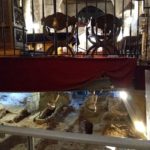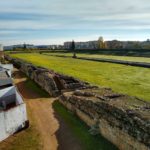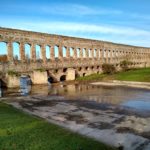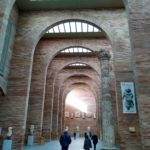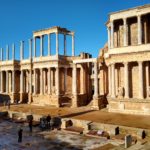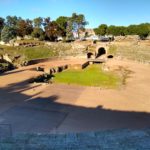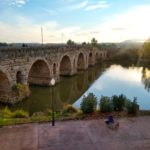Merida is a ‘medium’ sized town on the Toby Town Scale System™. This means that we have all the facilities that we might need local to us, and we can still get mothership into town and close to the ‘Things to Do’ and still (legally) park the beast somewhere. Legally in this case means a proper vehicle parking pound with a dedicated area for camper-vans.
So far, the electrical system has taken everything we have thrown at it and we have not yet had a flat (or even low) hab battery the whole time we have been away. So we will experiment with more days without mains juice and see how we get on. So we opt not to have the electric hookup for the 4 days we spend here and save ourselves €20.
Merida (https://en.wikipedia.org/wiki/M%C3%A9rida,_Spain) was founded by the Romans in 25 BCE as Emerita Augusta. The modern name Merida has evolved from that Roman name. It was important to the Romans as it lay at an important pass on a strategic route to the Spanish gold mines.
By about the year 500 CE the Roman buildings were all abandoned and stayed that way for about 1200 years with only a few features visible sticking out of the dirt. Around 1910, serious archeological excavations were started and they quickly uncovered the theatre, amphitheatre, circus and forum with many others to follow. To get an idea there are around 20 different UNESCO World Heritage sites in and around Merida.
So, Merida is wonderful: we spent four days exploring the ruins. Many have been excavated and the theatre for example has been sympathetically reconstructed. Other sites that are not yet open are protected from the elements and it seems that further excavations will be undertaken. The vacant derelict space next to the camping stop seems to be a site that will be fully investigated when time and funds allow.
One amazing building is the Crypt of Santa Eulalia. It’s especially interesting because it’s still a church, but the basement has been excavated to show the whole evolution of the building over more than a thousand years. The church floor is a steel platform so it’s possible to see both the modern church and the ancient buildings that made it up. It’s odd clanging around crypts and foundations on steel walkways trying hard to be quiet because above your head a baptism is going on!
We spend half a day at the National Museum of Roman Art, which is pretty new and massive – and – typically – the building has it’s own roman history.
There are a couple of things we need to buy so the only bummer was on the day we left, noticing an Amazon Locker right at the parking location. We’ve now checked and there don’t seem to be any more on our imminent route. Typical!
After four wonderful days in Merida, it’s motorway down to Seville. It’s been possible to measure the distance to Seville by looking at the mount of citrus trees in the various towns and villages! We are accelerating the pace a bit.

